Company Law Assignment - Corporate Law Case Study Analysis
VerifiedAdded on 2021/06/18
|6
|1197
|387
Homework Assignment
AI Summary
This document presents a comprehensive analysis of a company law assignment. It addresses two key issues: whether Martha can establish a company as the sole director and whether Gus breached his employment contract by starting a competing business. The analysis delves into relevant legal principles, including the concept of a separate legal entity as established in Salomon v A Salomon and Co Ltd, and the application of the Corporations Act 2001. The assignment also examines the Australian Contract Law, specifically the restraint of trade, referencing Bressan V Squires. The application section applies these rules to the given scenarios, concluding that Martha can successfully establish a company and Gus did not breach his contract. The analysis includes references to key legal cases and acts, providing a solid understanding of corporate and contract law principles. This assignment, available on Desklib, offers a clear and concise overview of the legal issues involved, providing valuable insights for students studying company law.
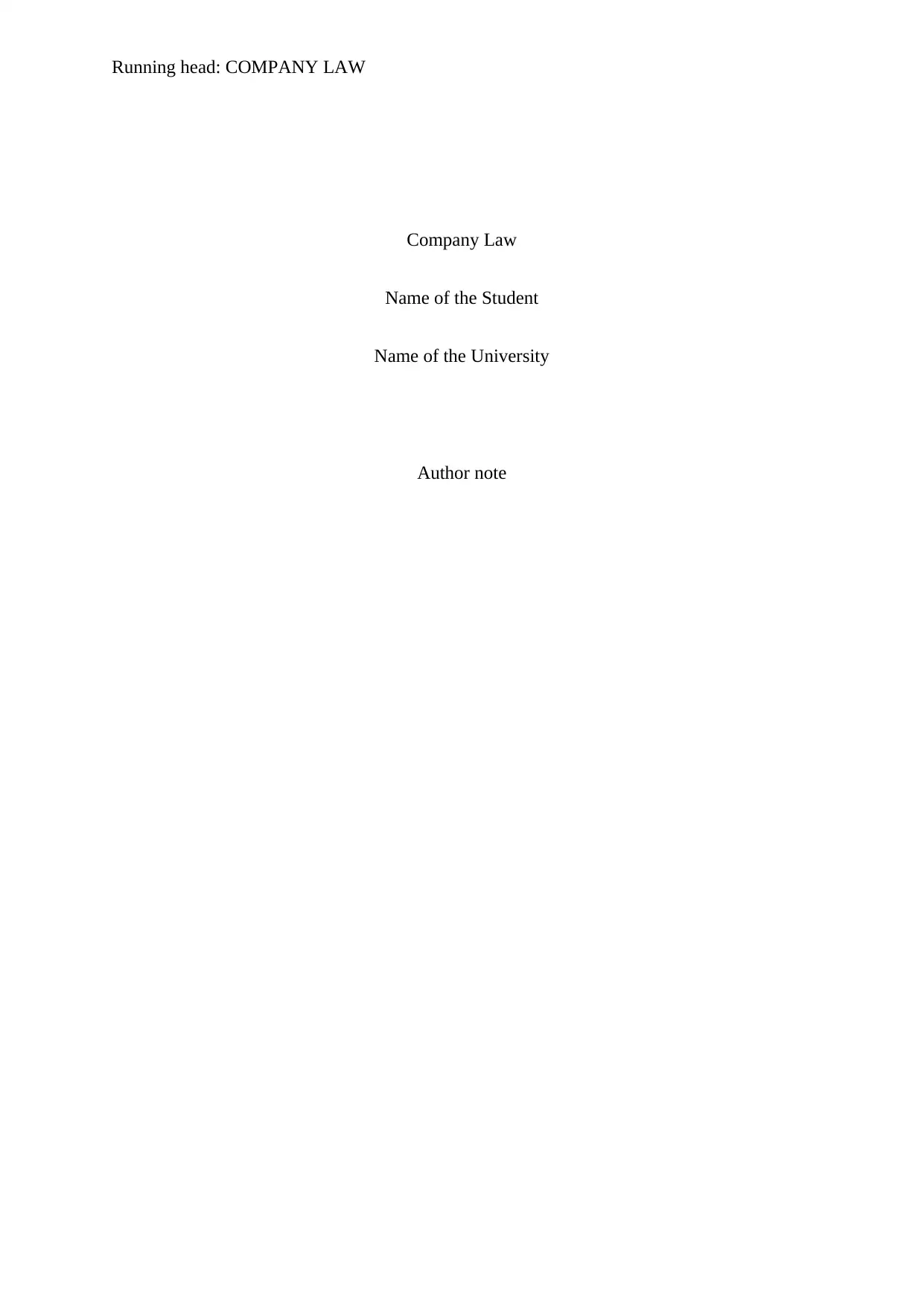
Running head: COMPANY LAW
Company Law
Name of the Student
Name of the University
Author note
Company Law
Name of the Student
Name of the University
Author note
Paraphrase This Document
Need a fresh take? Get an instant paraphrase of this document with our AI Paraphraser
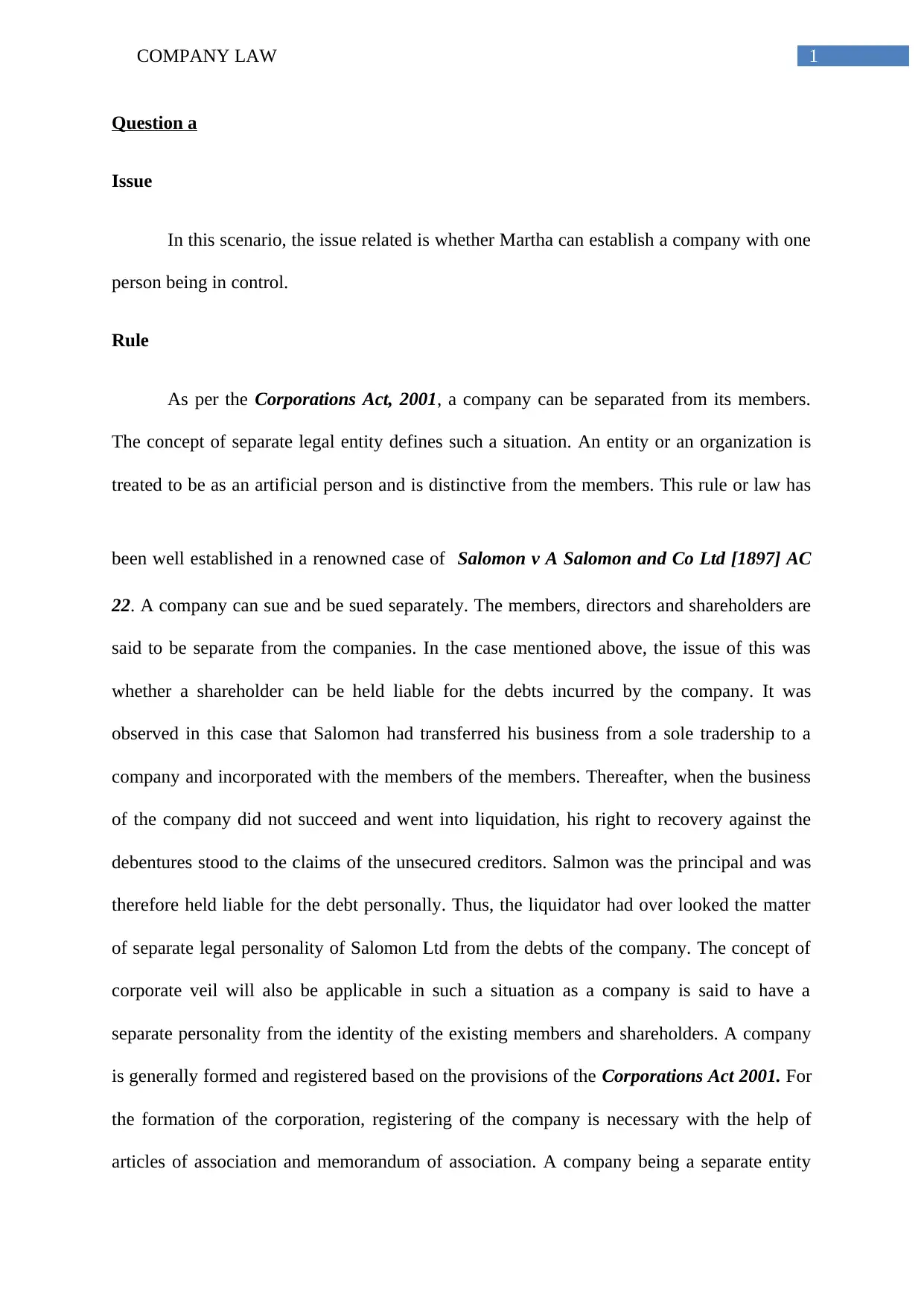
1COMPANY LAW
Question a
Issue
In this scenario, the issue related is whether Martha can establish a company with one
person being in control.
Rule
As per the Corporations Act, 2001, a company can be separated from its members.
The concept of separate legal entity defines such a situation. An entity or an organization is
treated to be as an artificial person and is distinctive from the members. This rule or law has
been well established in a renowned case of Salomon v A Salomon and Co Ltd [1897] AC
22. A company can sue and be sued separately. The members, directors and shareholders are
said to be separate from the companies. In the case mentioned above, the issue of this was
whether a shareholder can be held liable for the debts incurred by the company. It was
observed in this case that Salomon had transferred his business from a sole tradership to a
company and incorporated with the members of the members. Thereafter, when the business
of the company did not succeed and went into liquidation, his right to recovery against the
debentures stood to the claims of the unsecured creditors. Salmon was the principal and was
therefore held liable for the debt personally. Thus, the liquidator had over looked the matter
of separate legal personality of Salomon Ltd from the debts of the company. The concept of
corporate veil will also be applicable in such a situation as a company is said to have a
separate personality from the identity of the existing members and shareholders. A company
is generally formed and registered based on the provisions of the Corporations Act 2001. For
the formation of the corporation, registering of the company is necessary with the help of
articles of association and memorandum of association. A company being a separate entity
Question a
Issue
In this scenario, the issue related is whether Martha can establish a company with one
person being in control.
Rule
As per the Corporations Act, 2001, a company can be separated from its members.
The concept of separate legal entity defines such a situation. An entity or an organization is
treated to be as an artificial person and is distinctive from the members. This rule or law has
been well established in a renowned case of Salomon v A Salomon and Co Ltd [1897] AC
22. A company can sue and be sued separately. The members, directors and shareholders are
said to be separate from the companies. In the case mentioned above, the issue of this was
whether a shareholder can be held liable for the debts incurred by the company. It was
observed in this case that Salomon had transferred his business from a sole tradership to a
company and incorporated with the members of the members. Thereafter, when the business
of the company did not succeed and went into liquidation, his right to recovery against the
debentures stood to the claims of the unsecured creditors. Salmon was the principal and was
therefore held liable for the debt personally. Thus, the liquidator had over looked the matter
of separate legal personality of Salomon Ltd from the debts of the company. The concept of
corporate veil will also be applicable in such a situation as a company is said to have a
separate personality from the identity of the existing members and shareholders. A company
is generally formed and registered based on the provisions of the Corporations Act 2001. For
the formation of the corporation, registering of the company is necessary with the help of
articles of association and memorandum of association. A company being a separate entity
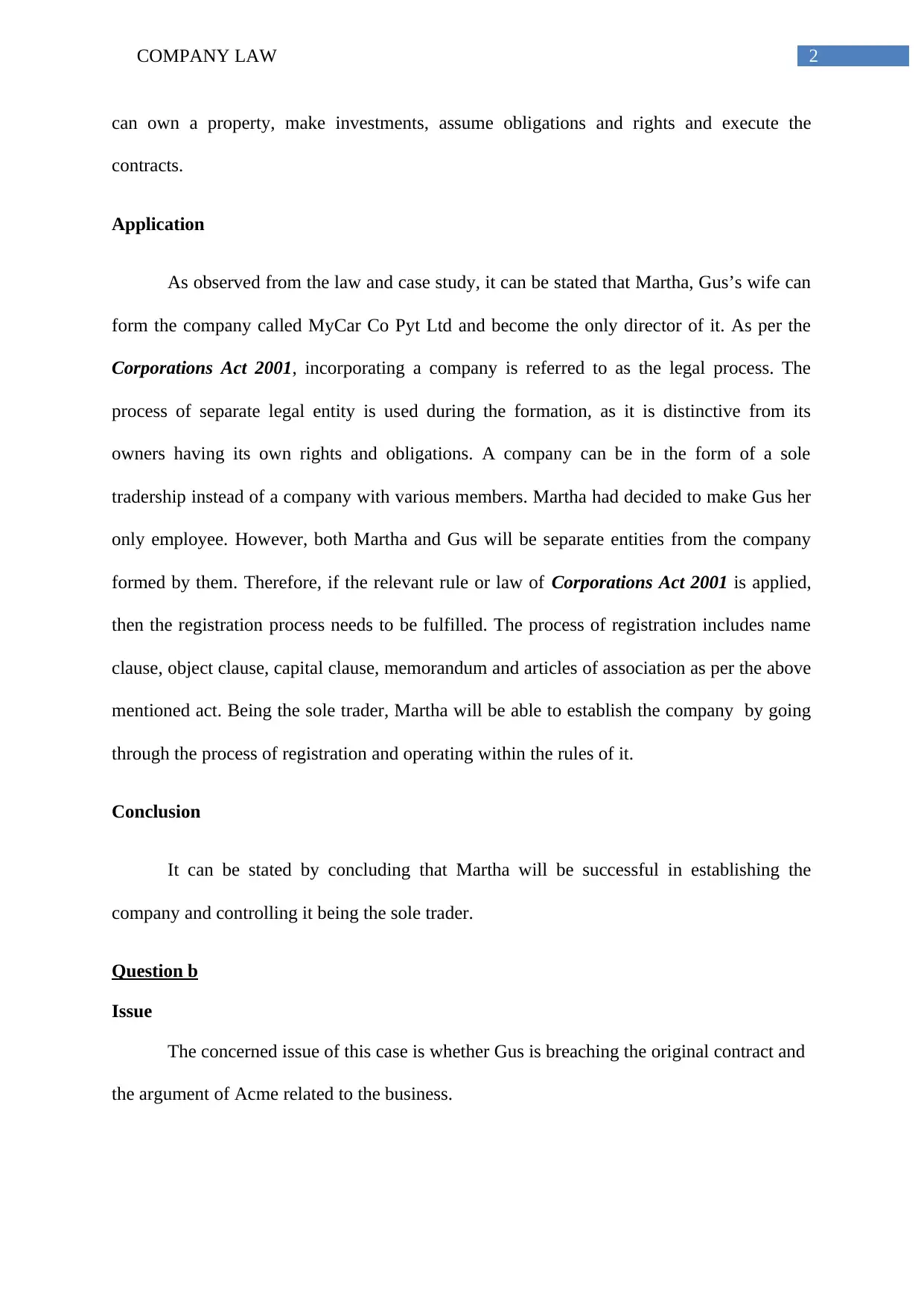
2COMPANY LAW
can own a property, make investments, assume obligations and rights and execute the
contracts.
Application
As observed from the law and case study, it can be stated that Martha, Gus’s wife can
form the company called MyCar Co Pyt Ltd and become the only director of it. As per the
Corporations Act 2001, incorporating a company is referred to as the legal process. The
process of separate legal entity is used during the formation, as it is distinctive from its
owners having its own rights and obligations. A company can be in the form of a sole
tradership instead of a company with various members. Martha had decided to make Gus her
only employee. However, both Martha and Gus will be separate entities from the company
formed by them. Therefore, if the relevant rule or law of Corporations Act 2001 is applied,
then the registration process needs to be fulfilled. The process of registration includes name
clause, object clause, capital clause, memorandum and articles of association as per the above
mentioned act. Being the sole trader, Martha will be able to establish the company by going
through the process of registration and operating within the rules of it.
Conclusion
It can be stated by concluding that Martha will be successful in establishing the
company and controlling it being the sole trader.
Question b
Issue
The concerned issue of this case is whether Gus is breaching the original contract and
the argument of Acme related to the business.
can own a property, make investments, assume obligations and rights and execute the
contracts.
Application
As observed from the law and case study, it can be stated that Martha, Gus’s wife can
form the company called MyCar Co Pyt Ltd and become the only director of it. As per the
Corporations Act 2001, incorporating a company is referred to as the legal process. The
process of separate legal entity is used during the formation, as it is distinctive from its
owners having its own rights and obligations. A company can be in the form of a sole
tradership instead of a company with various members. Martha had decided to make Gus her
only employee. However, both Martha and Gus will be separate entities from the company
formed by them. Therefore, if the relevant rule or law of Corporations Act 2001 is applied,
then the registration process needs to be fulfilled. The process of registration includes name
clause, object clause, capital clause, memorandum and articles of association as per the above
mentioned act. Being the sole trader, Martha will be able to establish the company by going
through the process of registration and operating within the rules of it.
Conclusion
It can be stated by concluding that Martha will be successful in establishing the
company and controlling it being the sole trader.
Question b
Issue
The concerned issue of this case is whether Gus is breaching the original contract and
the argument of Acme related to the business.
⊘ This is a preview!⊘
Do you want full access?
Subscribe today to unlock all pages.

Trusted by 1+ million students worldwide
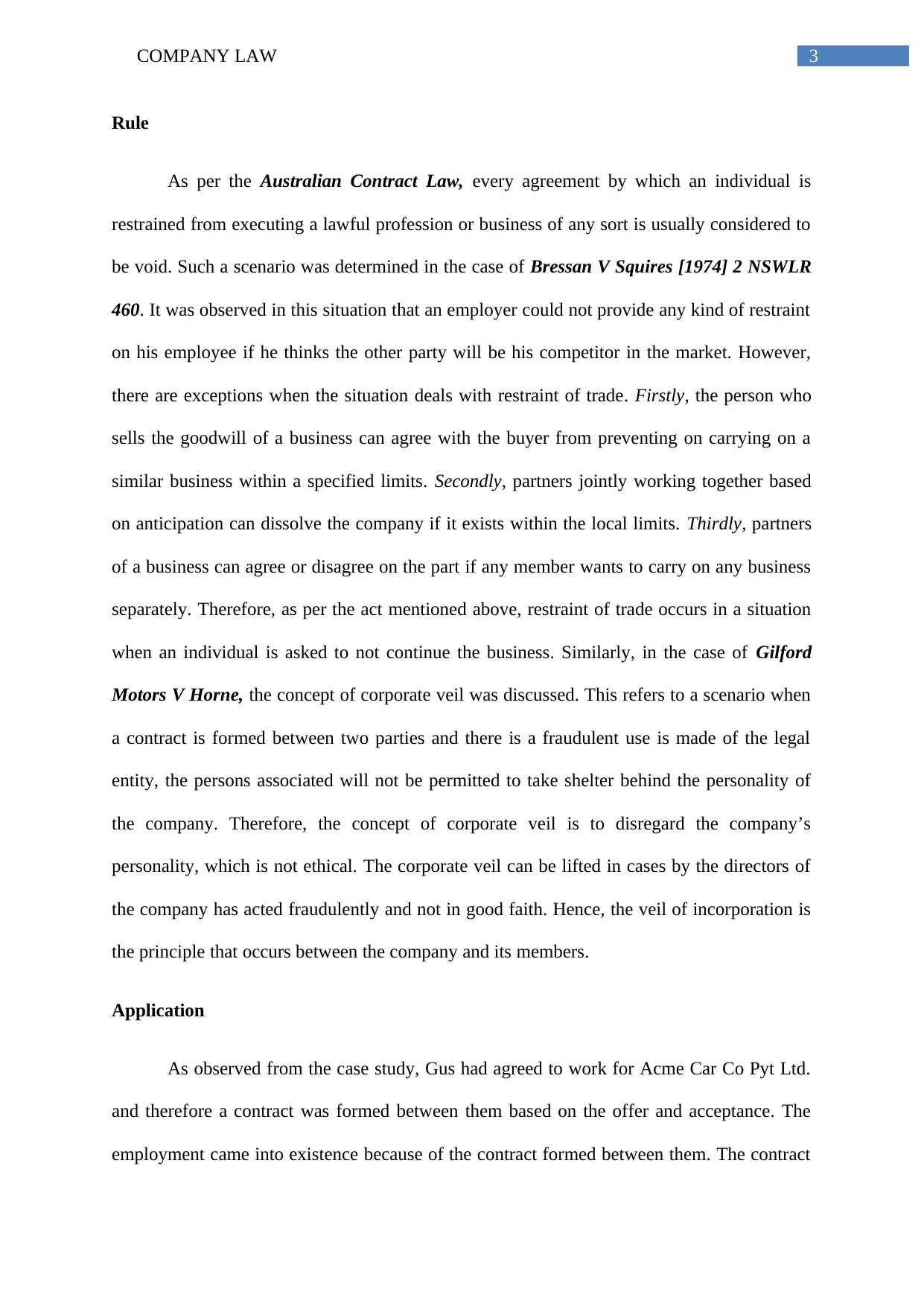
3COMPANY LAW
Rule
As per the Australian Contract Law, every agreement by which an individual is
restrained from executing a lawful profession or business of any sort is usually considered to
be void. Such a scenario was determined in the case of Bressan V Squires [1974] 2 NSWLR
460. It was observed in this situation that an employer could not provide any kind of restraint
on his employee if he thinks the other party will be his competitor in the market. However,
there are exceptions when the situation deals with restraint of trade. Firstly, the person who
sells the goodwill of a business can agree with the buyer from preventing on carrying on a
similar business within a specified limits. Secondly, partners jointly working together based
on anticipation can dissolve the company if it exists within the local limits. Thirdly, partners
of a business can agree or disagree on the part if any member wants to carry on any business
separately. Therefore, as per the act mentioned above, restraint of trade occurs in a situation
when an individual is asked to not continue the business. Similarly, in the case of Gilford
Motors V Horne, the concept of corporate veil was discussed. This refers to a scenario when
a contract is formed between two parties and there is a fraudulent use is made of the legal
entity, the persons associated will not be permitted to take shelter behind the personality of
the company. Therefore, the concept of corporate veil is to disregard the company’s
personality, which is not ethical. The corporate veil can be lifted in cases by the directors of
the company has acted fraudulently and not in good faith. Hence, the veil of incorporation is
the principle that occurs between the company and its members.
Application
As observed from the case study, Gus had agreed to work for Acme Car Co Pyt Ltd.
and therefore a contract was formed between them based on the offer and acceptance. The
employment came into existence because of the contract formed between them. The contract
Rule
As per the Australian Contract Law, every agreement by which an individual is
restrained from executing a lawful profession or business of any sort is usually considered to
be void. Such a scenario was determined in the case of Bressan V Squires [1974] 2 NSWLR
460. It was observed in this situation that an employer could not provide any kind of restraint
on his employee if he thinks the other party will be his competitor in the market. However,
there are exceptions when the situation deals with restraint of trade. Firstly, the person who
sells the goodwill of a business can agree with the buyer from preventing on carrying on a
similar business within a specified limits. Secondly, partners jointly working together based
on anticipation can dissolve the company if it exists within the local limits. Thirdly, partners
of a business can agree or disagree on the part if any member wants to carry on any business
separately. Therefore, as per the act mentioned above, restraint of trade occurs in a situation
when an individual is asked to not continue the business. Similarly, in the case of Gilford
Motors V Horne, the concept of corporate veil was discussed. This refers to a scenario when
a contract is formed between two parties and there is a fraudulent use is made of the legal
entity, the persons associated will not be permitted to take shelter behind the personality of
the company. Therefore, the concept of corporate veil is to disregard the company’s
personality, which is not ethical. The corporate veil can be lifted in cases by the directors of
the company has acted fraudulently and not in good faith. Hence, the veil of incorporation is
the principle that occurs between the company and its members.
Application
As observed from the case study, Gus had agreed to work for Acme Car Co Pyt Ltd.
and therefore a contract was formed between them based on the offer and acceptance. The
employment came into existence because of the contract formed between them. The contract
Paraphrase This Document
Need a fresh take? Get an instant paraphrase of this document with our AI Paraphraser
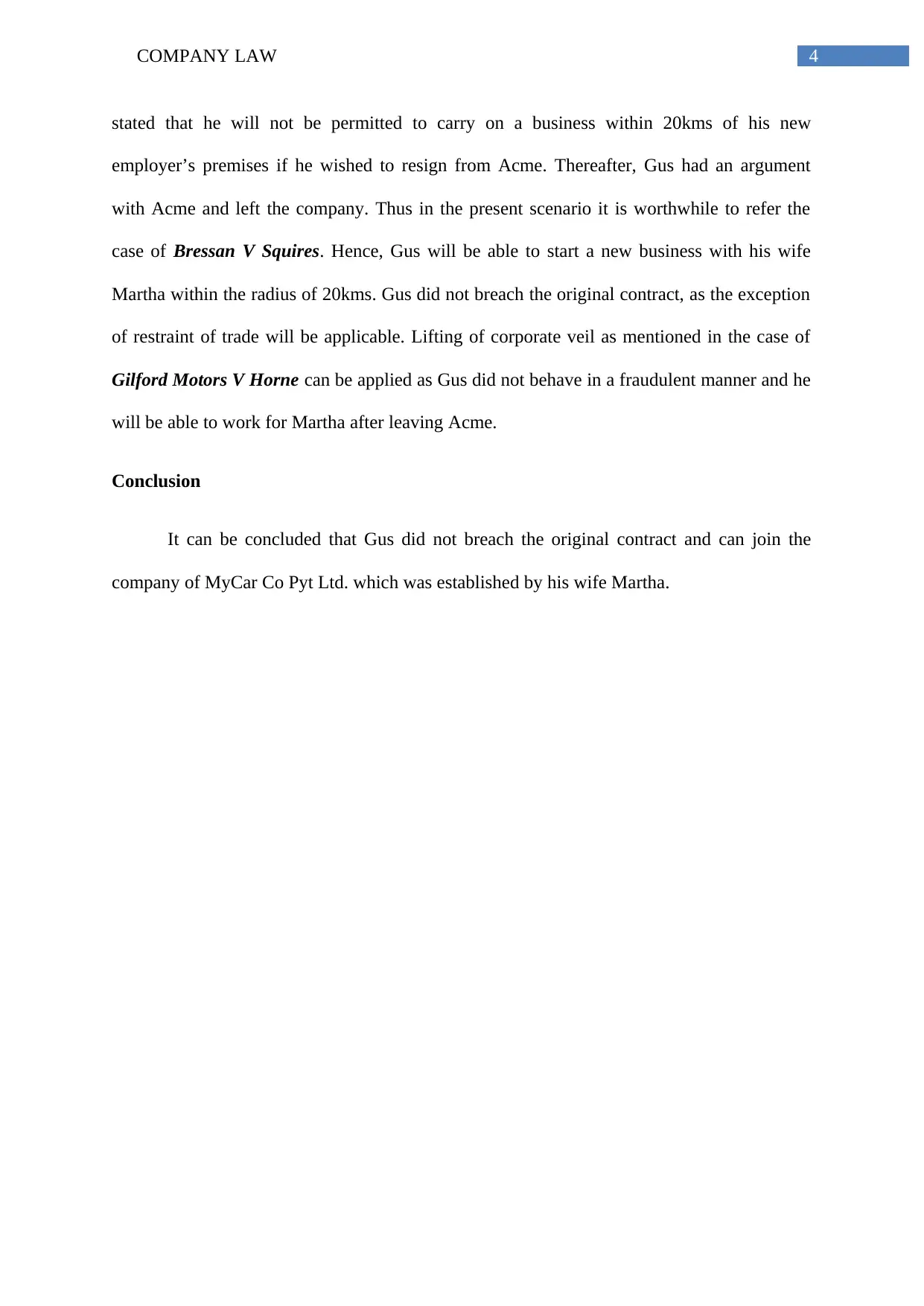
4COMPANY LAW
stated that he will not be permitted to carry on a business within 20kms of his new
employer’s premises if he wished to resign from Acme. Thereafter, Gus had an argument
with Acme and left the company. Thus in the present scenario it is worthwhile to refer the
case of Bressan V Squires. Hence, Gus will be able to start a new business with his wife
Martha within the radius of 20kms. Gus did not breach the original contract, as the exception
of restraint of trade will be applicable. Lifting of corporate veil as mentioned in the case of
Gilford Motors V Horne can be applied as Gus did not behave in a fraudulent manner and he
will be able to work for Martha after leaving Acme.
Conclusion
It can be concluded that Gus did not breach the original contract and can join the
company of MyCar Co Pyt Ltd. which was established by his wife Martha.
stated that he will not be permitted to carry on a business within 20kms of his new
employer’s premises if he wished to resign from Acme. Thereafter, Gus had an argument
with Acme and left the company. Thus in the present scenario it is worthwhile to refer the
case of Bressan V Squires. Hence, Gus will be able to start a new business with his wife
Martha within the radius of 20kms. Gus did not breach the original contract, as the exception
of restraint of trade will be applicable. Lifting of corporate veil as mentioned in the case of
Gilford Motors V Horne can be applied as Gus did not behave in a fraudulent manner and he
will be able to work for Martha after leaving Acme.
Conclusion
It can be concluded that Gus did not breach the original contract and can join the
company of MyCar Co Pyt Ltd. which was established by his wife Martha.
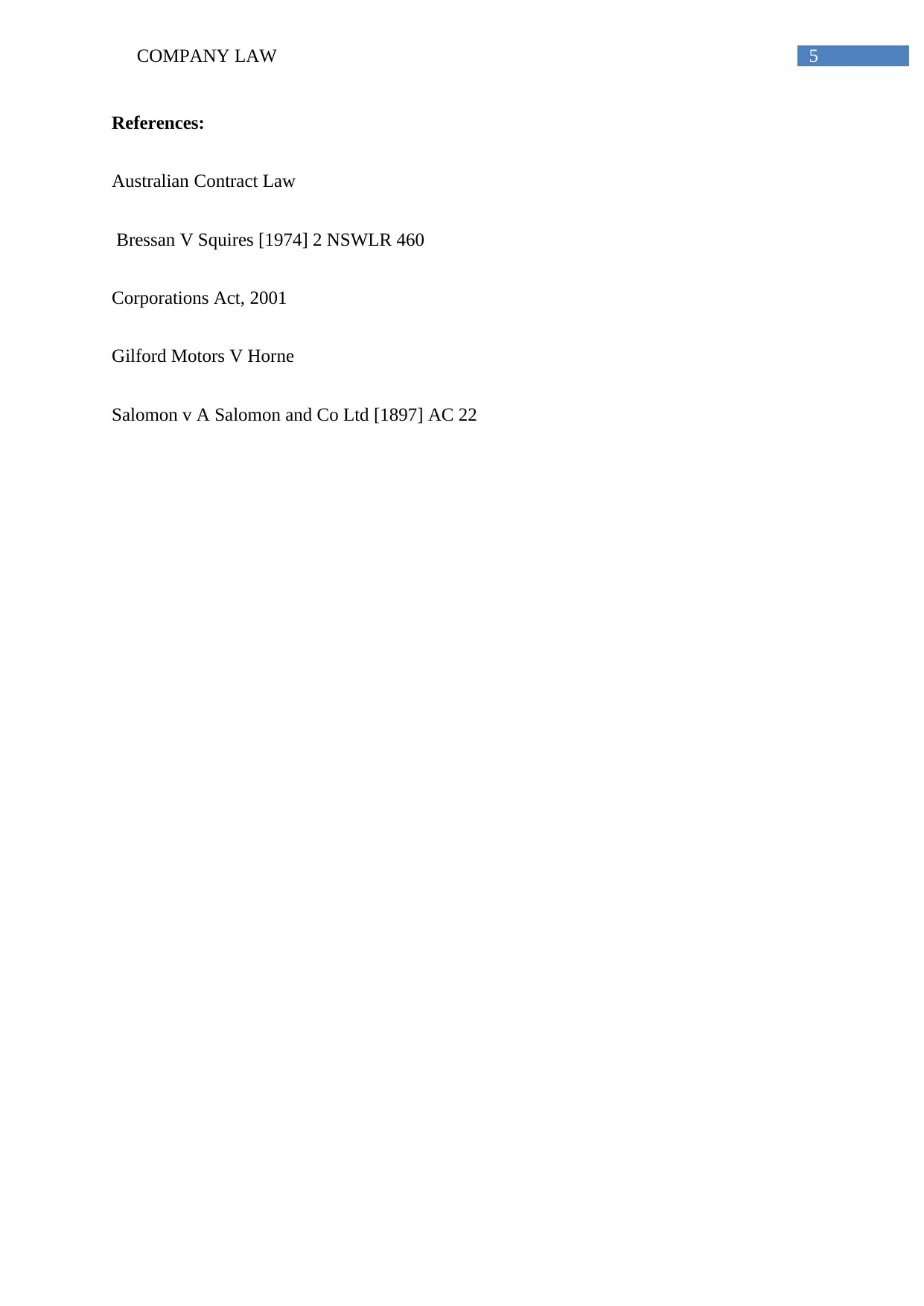
5COMPANY LAW
References:
Australian Contract Law
Bressan V Squires [1974] 2 NSWLR 460
Corporations Act, 2001
Gilford Motors V Horne
Salomon v A Salomon and Co Ltd [1897] AC 22
References:
Australian Contract Law
Bressan V Squires [1974] 2 NSWLR 460
Corporations Act, 2001
Gilford Motors V Horne
Salomon v A Salomon and Co Ltd [1897] AC 22
⊘ This is a preview!⊘
Do you want full access?
Subscribe today to unlock all pages.

Trusted by 1+ million students worldwide
1 out of 6
Related Documents
Your All-in-One AI-Powered Toolkit for Academic Success.
+13062052269
info@desklib.com
Available 24*7 on WhatsApp / Email
![[object Object]](/_next/static/media/star-bottom.7253800d.svg)
Unlock your academic potential
Copyright © 2020–2025 A2Z Services. All Rights Reserved. Developed and managed by ZUCOL.





